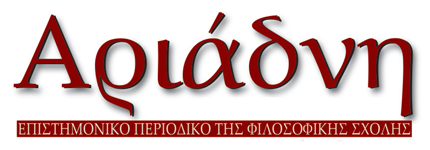Remarks on the marginal notes in codex Palatinus Graecus 398 (the stories of Parthenius and Antoninus Liberalis)
DOI:
https://doi.org/10.26248/ariadne.v0i23-24.794Περίληψη
CODEX Palatinus Graecus 398, which is now stored at the Universitäsbibliothek at Heidelberg, has attracted the interest of many scholars because it preserves unique and valuable texts, such as the collections of Parthenius (Erotica Pathemata) and Antoninus Liberalis (Metamorphoses), Pseudo-Strabo’s Chrestomathy, and diverse works of geographers, paradoxographers and others.
In this paper, I will focus on folios 173v–188v, which contain Parthenius’ collection, but I will take into consideration the usus scriptoris in the whole codex. Although marginal notes appear throughout the codex to a greater or lesser extent, the folios which include Parthenius’ and Antoninus Liberalis’ works have a genuine characteristic in common. That is, there are ascriptions on the top and the bottom of the pages, referring to other authors and works. Moreover, Parthenius incorporates, in some cases, in his main narrative original verses of other authors and works, which are often lengthy.
These ascriptions seem to exhibit two areas of concern. The first is about their credibility and the second is about their authenticity. Moreover, these ascriptions are also connected with another important problem, that is, the interpretation of the sign õ.
The fact that in some stories the ascriptions are missing, and the fact that Parthenius refers to his sources in an indefinite way within his main narrative, make it unlikely that the ascriptions stem from him. However, one cannot argue that the ascriptions contrast with what Parthenius quotes within his main narrative.
After the discovery of the papyrus fragments of Euphorion’s Thrax it became clear that, at least in the cases of EP 13 and 26, the author quoted in the ascriptions (that is, Euphorion) had dealt with these stories too. However, these fragments do not prove that the Thrax was Parthenius’ main source, since details mentioned by Parthenius are missing in the Thrax. The only thing we can safely deduce from this comparison is that there is a thematic relationship and that the Thrax offers rather a parallel story.
One can also notice a tendency of the scribe to record allusions to other authors. Given this tendency and given also the similar way in which the ascriptions are cited in both Parthenius and Antoninus (although Antoninus never quotes other authors within his main text, he never introduces his stories with indirect speech and never introduces versions of the story), one can be inclined to take these as the products of later scholars and scribes. Although the codex has been preserved to us with uniformity (only one hand, besides the corrector), I believe that it is very likely that the ascriptions were produced as early as in the 2nd century AD and that they were produced prior to the sign õ.
Λήψεις
Δημοσίευση
Πώς να δημιουργήσετε Αναφορές
Τεύχος
Ενότητα
Άδεια
Οι εργασίες που δημοσιεύονται στο περιοδικό μπορούν να χρησιμοποιηθούν ελεύθερα για μη-εμπορικούς σκοπούς με την προϋπόθεση ότι γίνεται αναφορά στους συγγραφείς και την πρώτη δημοσίευση. Στην περίπτωση που το άρθρο αλλοιωθεί, τροποποιηθεί ή δημιουργηθεί κάτι νέο βασισμένο στο αρχικό, το έργο που θα προκύψει θα μπορεί να διανεμηθεί μόνο με την ίδια ή παρόμοια άδεια (Creative Commons Attribution-NonCommercial-ShareAlike 4.0 International License).


